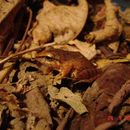Brief Summary
(
Inglês
)
fornecido por IABIN
Diagnosis Distinct toe disk with circumferential grooves and lacking toe webbing or fringes. With distinctive rows of almost parallel ridges on the dorsal surface of the body.
- licença
- cc-by-nc-sa-3.0
- direitos autorais
- Museo Nacional de Historia Natural
- autor
- Esteban O. Lavilla
- editor
- Diego Arrieta
Distribution
(
Inglês
)
fornecido por IABIN
Present in the Atlantic Rain Forest of Brazil from south of the Bahia state to north of Rio Grande do Sul State.
- licença
- cc-by-nc-sa-3.0
- direitos autorais
- Museo Nacional de Historia Natural
- autor
- Esteban O. Lavilla
- editor
- Diego Arrieta
Diagnostic Description
(
Inglês
)
fornecido por IABIN
Adult morphology Vomerine teeth in large, slanting, well-separated arcs behind the choanae; tongue slightly more than one-half the width of mouth-opening, rounded, with a notch in its free posterior border; snout long, bluntly pointed when seen from above and in profile, the upper jaw projecting considerably beyond lower; nostrils lateral, their distance from end of snout one-half their distance from eye, separated from each other by an interval equal to three-fourths their distance from eye. Canthus rostralis sharp; loreal region flat, the upper lip flaring outwards below it. Eye large, very prominent, its diameter four-fifths the length of snout; interorbital diameter slightly greater than width of upper eyelid, 1 1/2 times the distance between nostrils. Tympanum distinct, one-half the diameter of eye, separated from eye by two-thirds its own diameter. Fingers rather short, free, second shorter than fourth, first longer than second and fourth, all with rounded tips, which are only slightly dilated ; a heavy pointed elongate pad at base of first finger and a flattened oval one on palm; all metacarpal tubercles very greatly developed; toes moderately long, free, with slightly dilated tips, third slightly longer than fifth and reaching to base of antepenultimate phalanx of fourth; a small conical inner metatarsal tubercle and a rounded, flat outer one; metatarsal tubercles very well developed, those below the proximal joints being larger than the inner metatarsal tubercle; no tarsal ridges, instead a row of weak round or elongate glandules on outside of tarsus. Body rather stout, in postaxillary region equal to greatest head width. When hind leg is adpressed, heel reaches a little beyond tip of snout; when limbs are laid along the side, knee and elbow greatly overlap; when hind legs are bent at right angles to body, heels overlap. Skin of upper parts minutely glandular, with 8 to 10 fine, broken, sinuous granular ridges from posterior half of each eyelid to the sacral region; some small granules above coccyx, extending onto posterior femur; a narrow, distinct supratympanic ridge, with rounded heavy glandules at corner of mouth and smaller ones in front of tympanum. Venter smooth, with a prominent ventral disk. No apparent external vocal sac. Color in alcohol: Dorsum pale olive-yellow; a dark brown stripe along canthal region; a pair of light brown spots where the glandules end at sacrum; three pale gray crossbars on femur and tibia, and one or two fainter ones on forearm; upper lip pale gray, with traces of light diagonal bars in front of and behind the eye; venter immaculate pale buff. Color in life: Upper surface clay color tinged with vinaceous-buff. A clove-brown stripe along the canthus, ending behind ear, and a clove-brown stripe along outer side of tibia. Pupil gold above, with a brown line through it; below more coppery and greenish, the entire area sprinkled with fine black dots.
- licença
- cc-by-nc-sa-3.0
- direitos autorais
- Museo Nacional de Historia Natural
- autor
- Esteban O. Lavilla
- editor
- Diego Arrieta

